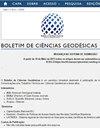AN APPROACH TO POSITIONAL QUALITY CONTROL METHODS FOR AIRBORNE INSAR HIGH-RESOLUTION X-BAND ORTHOIMAGES AND P-BAND DIGITAL TERRAIN MODEL
IF 0.5
Q3 Earth and Planetary Sciences
引用次数: 0
Abstract
Abstract: The positional validation of datasets is an important step for cartography studies since it allows learning about its accuracy, and also indicates the data process quality. However, the positional validation of Synthetic Aperture Radar (SAR) datasets have some additional challenges when compared to optical images due to the geometric distortions. We employ existing targets such as traffic signs and lampposts in the scene and identify them on the image as control points. We performed the validation of the geographic coordinates used as planialtimetric positional control points, using both the amplitude backscattering orthoimage and the Digital Terrain Model (DTM) generated from the InSAR system. We employed the NMAS, ASPRS and NSSDA tests along with information by the Brazilian Standards. This validation showed these control points presented the following results for 1:10,000 scale: NMAS test - class “A” in PEC and PEC-PCD; ASPRS test - RMSE x = 1.317m, RMSE y = 1.231m and RMSE z = 1.145m; and NSSDA test - RMSE r = 1,802m, Precision r = 3.118m and Precision z = 2.244m. These results prove we can use the proposed targets as control points and the used InSAR datasets meet the expected quality for generation of geotechnic products for 1:10,000 scale.机载insar高分辨率x波段正射影像和p波段数字地形模型的位置质量控制方法研究
摘要:数据集的位置验证是制图研究的重要一步,因为它可以了解其准确性,也可以指示数据处理质量。然而,由于几何失真,与光学图像相比,合成孔径雷达(SAR)数据集的位置验证具有一些额外的挑战。我们使用场景中的交通标志和灯柱等现有目标,并在图像上识别它们作为控制点。我们使用InSAR系统生成的振幅反向散射正射图像和数字地形模型(DTM)对用作平面时间位置控制点的地理坐标进行了验证。我们采用了NMAS、ASPRS和NSSDA测试以及巴西标准提供的信息。该验证表明,这些控制点在1:10000比例下呈现出以下结果:NMAS测试——PEC和PEC-PCD中的“A”级;ASPRS测试——RMSE x=1.317m,RMSE y=1.231m,RMSE z=1.145m;NSSDA测试-RMSE r=1802m,精度r=3.118m,精度z=2.244m。这些结果证明我们可以使用所提出的目标作为控制点,并且所使用的InSAR数据集满足生成1:10000比例尺土工产品的预期质量。
本文章由计算机程序翻译,如有差异,请以英文原文为准。
求助全文
约1分钟内获得全文
求助全文
来源期刊

Boletim De Ciencias Geodesicas
Earth and Planetary Sciences-General Earth and Planetary Sciences
CiteScore
1.70
自引率
20.00%
发文量
10
审稿时长
3 months
期刊介绍:
The Boletim de Ciências Geodésicas publishes original papers in the area of Geodetic Sciences and correlated ones (Geodesy, Photogrammetry and Remote Sensing, Cartography and Geographic Information Systems).
Submitted articles must be unpublished, and should not be under consideration for publication in any other journal. Previous publication of the paper in conference proceedings would not violate the originality requirements. Articles must be written preferably in English language.
 求助内容:
求助内容: 应助结果提醒方式:
应助结果提醒方式:


